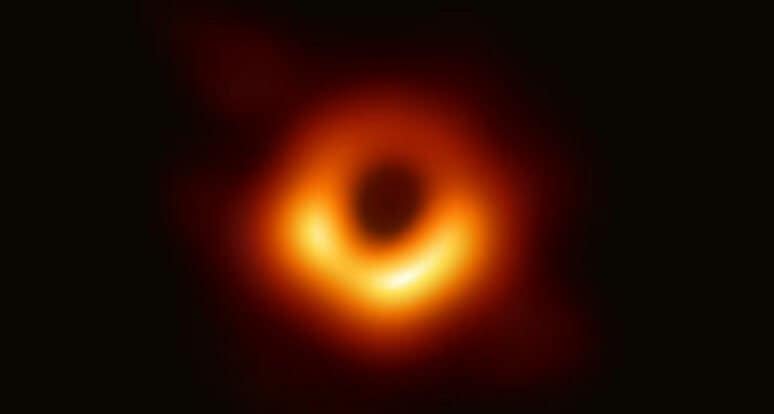
In the middle of the 18th century, the English geologist John Michell brought attention to the potential presence of black holes in the universe. Michell hypothesized that if a star possessed the same density as the Sun but was 500 times smaller in size, its first cosmic velocity would surpass the speed of light. As a result, if the law of universal gravitation applied to light, it would be impossible for light to escape the surface of such a star, rendering it completely black from an external perspective.
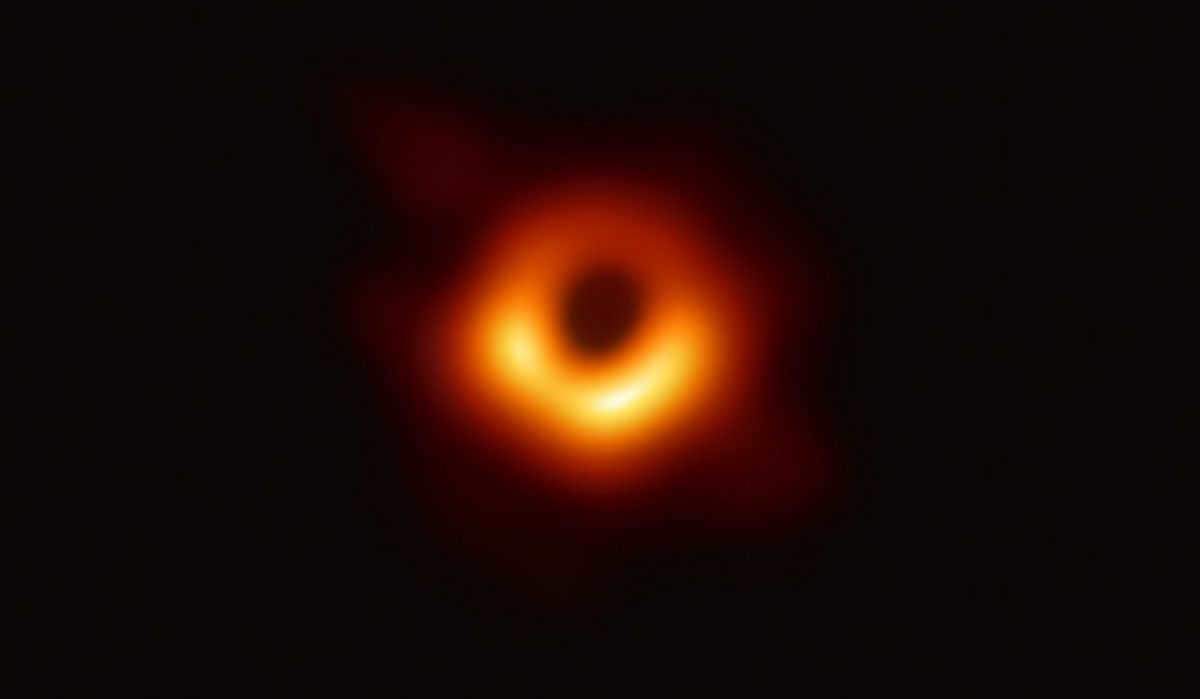

The initial direct visual representation of a supermassive black hole and its silhouette at the center of the M87 galaxy
The extraordinary fascination with the possibility of “all-consuming” stars in the universe somewhat diminished upon the realization that light is a form of electromagnetic radiation and, as such, should remain unaffected by gravitational forces. Convinced by this line of reasoning, the renowned 18th-century scientist Pierre-Simon Laplace made the decision to exclude any mention of black cosmic bodies so incredibly dense that even light rays cannot escape their boundaries from his book “The World System.”
Distortion of the space-time continuum in four dimensions
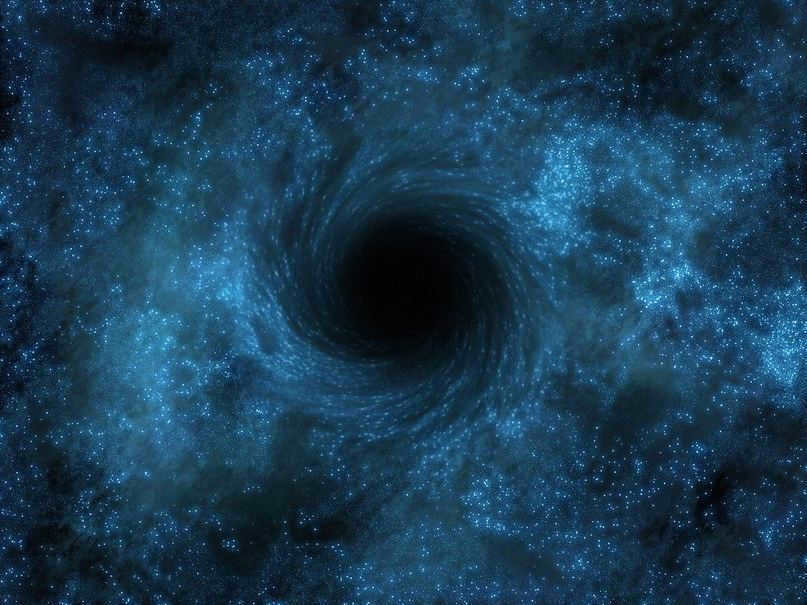

The artist’s interpretation of a black hole
There has been a renewed surge of interest in these enigmatic cosmic entities following the development of David Hilbert and Albert Einstein’s general theory of relativity. This theory posits that the gravitational field is a curvature of the four-dimensional space-time continuum, where light cannot travel in a straight line as it does not exist in this space. It is believed that the space can be so curved that light becomes trapped in a closed region, resulting in the formation of a black hole. However, not all aspects of this theory have been empirically confirmed…
Exploring the depths of a black hole.
In the past, Kip Thorne, a renowned astrophysicist, proposed the idea that black holes, which are formed around stars, could have concentric rings resembling a vibrant rainbow halo. This concept suggests that if a beam of light is influenced by the gravitational force of a black hole, it can circle around it for a period of time, emitting a small amount of light. However, in order to witness this phenomenon, it is crucial for the black hole to be in close proximity and for a luminous star to be positioned behind it.
It is more probable for them to be present rather than absent, though their presence cannot be conclusively demonstrated at this time
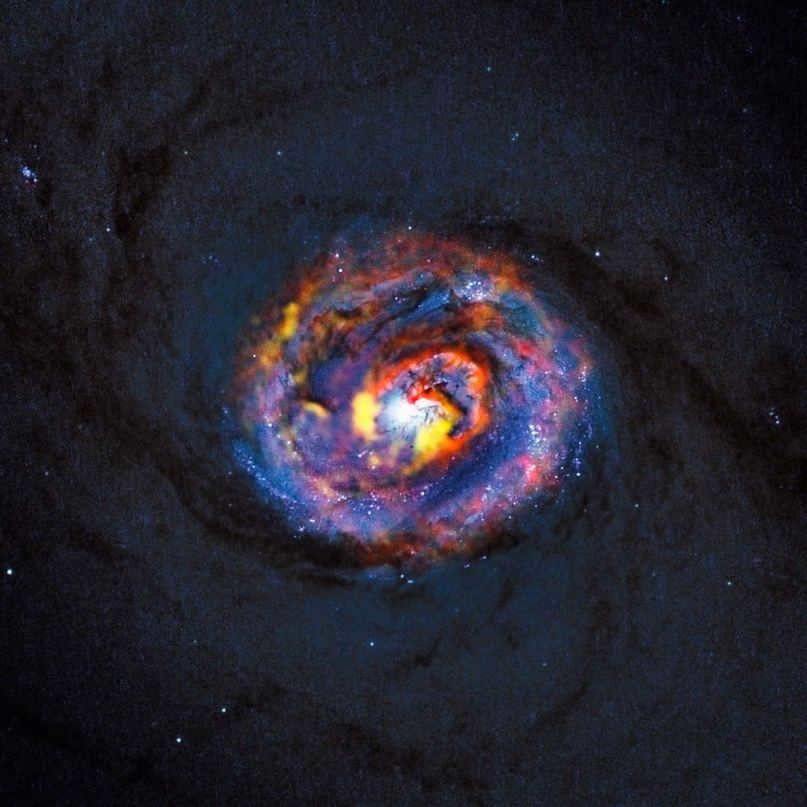
Composite view of the NGC 1433 galaxy featuring a black hole located at its core.
Contemporary astrophysicists theorize that inside a black hole, time ceases and space becomes curved. However, providing concrete evidence for this notion is a challenging task, just like confirming the actual existence of black holes themselves. Due to their lack of emissions, observing them is impossible.
A computer-generated representation illustrating the visual experience of an observer who has entered a black hole.
There is now very little uncertainty regarding the presence of black holes in the cosmos, however it is impossible to determine definitively who and when initially identified this phenomenon or provided evidence that the celestial object under investigation is indeed a black hole.
Did you find this article enjoyable? Share it with your acquaintances!
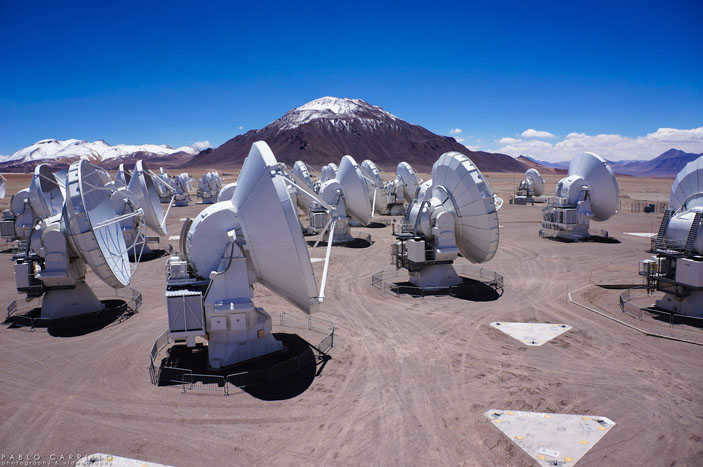
Maybe there has never been a more inspiring picture than the one that was taken on April 10, 2019, which was initially blurry and difficult to understand. This particular image has been widely shared across reputable media outlets, inundated social media platforms, become a popular subject for photoshop enthusiasts, appeared on t-shirts, and even managed to be somewhat bothersome. The image itself captures the very first depiction of an actual black hole – a massive void located at the core of the M87 galaxy. Although the quality of the image is poor, it is undeniably authentic.
Astrophysical Background
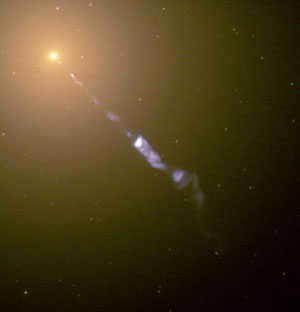
Figure 1. This image shows an optical jet in M87, captured by the Hubble Space Telescope (NASA).
Observations possible from a black hole
Black holes, remnants of individual stars, have an upper limit on their angular size of approximately 10 to 15 radians. At this particular angle, even the tiniest bacteria on Earth can be observed from the Moon. Fortunately, the size of a black hole is directly proportional to its mass (instead of the cube root, as is the case for regular objects), which means that supermassive black holes located at the centers of galaxies, having consumed the mass of millions or billions of stars, offer much more potential. The current record holders for angular size are a supermassive black hole (approximately 6 billion times the mass of our Sun) in the relatively nearby galaxy M87 (55 million light years away) and a black hole located at the center of our own galaxy, which is a thousand times smaller (4 million times the mass of our Sun), but two thousand times closer. The angular size of these black holes is significantly larger, approximately 10 to the power of -10: at such an angle, a ping-pong ball on the Moon or a human hair with a thickness of 500 km would be visible. In the field of astrophysics, it is customary to measure angular size in arcseconds, which is equal to 1/3600th of a degree or 0.5 x 10^(-5) radians. In this case, a more appropriate unit of measurement would be arc microseconds. The distance to the M87 galaxy is 16.4 megaparsecs, which is equivalent to 5 x 10^25 cm. Here are the main parameters of the black hole (with the primary measurements given in arc microseconds).
- The gravitational radius of the black hole in M87 (Rg) is about 10 15 cm, which is over three times the orbital radius of Neptune. It is defined in terms of the mass M, gravitational constant G, and the speed of light as Rg = GM/c 2 . The angular size is 4 microseconds.
- The Schwarzschild radius of a non-rotating black hole, which is the radius of the event horizon where no signal can escape outward, is twice as large: Rs = 2Rg (8 microseconds).
- The radius of the last stable orbit is: Ro = 6Rg (24 microseconds).
- The photon sphere has a radius of Rph = 3Rg. If a photon passes the black hole tangentially and comes closer than Rph, it will collide with the black hole. If it flies farther away, it will follow the curve to infinity. If it flies exactly at a distance of Rph, it will orbit the black hole in a circular path.
The black hole’s shadow has a radius of Ra = 5.2Rg. This shadow is essentially a lensed photon sphere (see Fig. 2). It has an angular size of 20 microseconds.
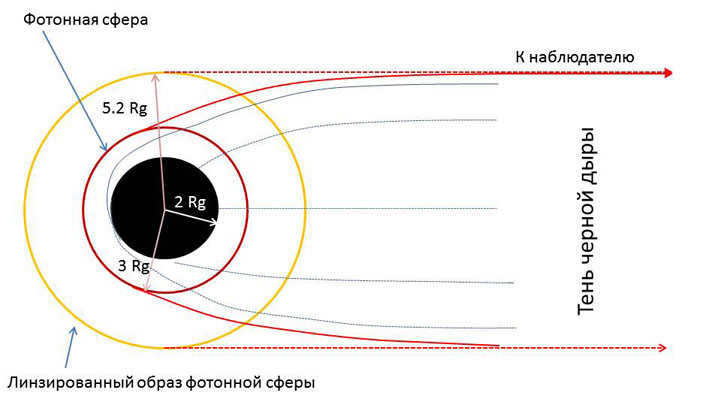

Figure 2. The diagram illustrates the shadow of a black hole. The curves represent the geodesic lines that light follows. The gray color indicates the lines that lie on the black hole’s horizon. However, if there is incident light between the photon sphere and the horizon, a portion of the shadow may be faintly illuminated.
Technique of observation
The angular resolution of a telescope or interferometer is limited by a phenomenon known as diffraction. This limit is determined by the wavelength (λ) and the aperture size (D) of the instrument. In the case of optical telescopes, the diffraction limit is typically around 10 milliseconds. For radio interferometers operating at longer wavelengths, such as a few centimeters, the diffraction limit is about a millisecond, determined by the size of the Earth. However, the Radioastron mission, which includes a space-based antenna, achieves a resolution about 30 times better due to its unique positioning. Despite this improvement, the long wavelength used by Radioastron prevents observation of the immediate vicinity of a black hole due to synchrotron self-absorption caused by high-energy electrons in the surrounding space. The core of M87 was studied using Radioastron, revealing an opaque photosphere that conceals the black hole and the inner regions of the accretion disk. However, at a wavelength of approximately a millimeter, synchrotron absorption decreases significantly, allowing for the emission of electrons with minimal absorption.
The EHT project, also known as the Event Horizon Telescope, is a collection of radio telescopes located in various parts of the world that work together as an interferometer. These telescopes specifically operate in the millimeter range, and for the study of the core of M87, they used a wavelength of 1.3 mm. With this wavelength and the Earth’s diameter as the baseline, the diffraction limit is approximately 20 angular microseconds, which matches the radius of the black hole’s shadow in M87.
With such a high resolution compared to the size of the object, radio interferometry allows for the generation of clear images. In fact, when dealing with simple object geometry, the position of a point object can be determined with an accuracy that is 20-30 times higher than the diffraction limit.
Ultra-long-baseline radio interferometry differs significantly from traditional interferometry because it operates digitally rather than analogously. In simple terms, the signal’s time profile from all antennas is recorded at a frequency that is twice the bandwidth of the received signal. While this frequency is much lower than 230 gigahertz, it is still quite high, resulting in a substantial amount of primary data, approximately two petabytes. The next step involves identifying delays at which the signal profiles from various antennas correlate with one another. These delays, combined with the spatial positions of the antennas, allow for the determination of the wave front’s direction of arrival. Finally, a map of the object is created based on the collection of delays.
Incidentally, prior to the integration of millimeter-wavelength antennas into the EHT network, the primary hub of this network, the ALMA interferometer, comprised of numerous antennas, captured breathtaking images of protoplanetary disks (refer to Figure 3).

Figure 3. Displaying the capabilities of millimeter-range interferometry: photographs of protoplanetary disks captured by one of the nodes in the EHT network – the ALMA interferometer.
Do you remember the story “Beetle in the Anthill” by the Strugatsky brothers, where they mention the journey of the unique starship “Darkness” inside the black hole EH 200056? If humanity ever reaches the point of attempting such an experiment, what would the outcomes be?

A celestial volcano
The situation within the whirling abyss is much more captivating. The key point is that it possesses two distinct outer boundaries: the event horizon and the static limit. The static limit marks the boundary of the area where any object can no longer remain stationary in relation to a distant observer, but must orbit around the black hole to avoid falling in. In a non-rotating abyss, the event horizon and the static limit coincide, while in a rotating abyss, they only touch at the poles (they are not perfectly spherical, but rather flattened along the axis of rotation). While traversing the space between these boundaries (known as the ergosphere), Captain “Darkness” still has the ability to turn back and return to our universe.
The Depths of the Abyss
What occurs if the “Blackness” dares to plunge into the abyss? Once it breaches the event horizon, the spaceship will be irresistibly drawn into the depths, much like one would expect when descending into a zero-momentum chasm. Consequently, just below the event horizon lies a “time-like” expanse akin to that of a non-rotating abyss, except now it doesn’t extend all the way to the core. Within this space, there exists a second horizon, enclosing ordinary space (albeit highly curved), where movement in various directions is feasible.

However, it is important to exercise caution in this area. Within this region, specifically within its equatorial plane, there exists a region where the curvature of spacetime, and consequently gravity, approaches infinity – a singularity. However, unlike a non-rotating black hole where the singularity is a point, in this case, it takes the form of a closed ring. It is highly advised not to approach this ring singularity due to the catastrophic tidal forces it generates. Nevertheless, it is possible for a starship to follow a trajectory that will keep it perpetually inside the second horizon, preventing it from falling onto the ring singularity. However, once inside this region, the starship will never be able to cross back over the horizon and return to the “time-like” space.
Flying Across
If we assume that the “Darkness” is soaring “overhead” the singularity in the “northern area” of inner space. The commander has the option to guide the spaceship “south” by either orbiting around the singularity or passing through an aperture in the ring of the singularity. Both paths are feasible, yet they lead to distinct spaces without a single shared point! Taking a detour would leave the spaceship inside the second boundary of the same aperture. On the other hand, leaping through the ring holds the promise of much more – the starship can follow a trajectory that cuts across both boundaries and transports it to regular space outside the aperture. However, this will be the space of a different universe – a negative universe.
Given that weightless spacecraft are improbable in the far future, the courageous astronauts are unlikely to experience any positive outcomes. It is possible to speculate that as soon as the spacecraft crosses the outer event horizon, it will encounter disturbances within the structure of the black hole, resulting in the emission of powerful gravitational waves. These gravitational disturbances will irreversibly disrupt the previous symmetry of the internal space of the black hole, thus eliminating any possibility of a breakthrough into another universe.
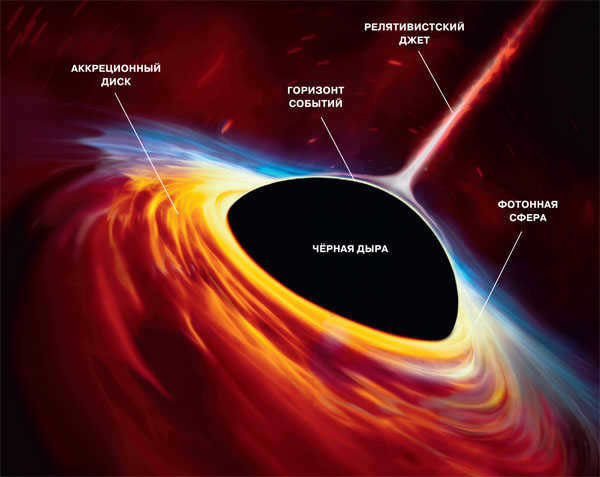
A significant breakthrough has been made by astronomers who have successfully captured the very first image of a supermassive black hole located at the core of a galaxy. However, what does this image reveal, how was it obtained, and why was the M87 galaxy specifically chosen for this groundbreaking achievement?
Black holes, which are extraordinary celestial entities predicted by Einstein’s theory of general relativity, possess immense mass and remarkably compact sizes. Their gravitational force is so powerful that it prevents even light from escaping. The boundary marking the region from which light cannot escape is known as the event horizon, with its radius being referred to as the gravitational radius. The gravitational radius is regarded as the size of a black hole.
The significance of the term “event horizon” lies in the fact that any information pertaining to events occurring within this boundary will never be able to reach an observer positioned outside of it. This is due to the fact that light originating from points within the boundary is unable to escape the gravitational pull of the black hole. To us, these events appear to be situated beyond the horizon.
There are two types of black holes based on their origin. The first type consists of stellar mass black holes, which are remnants of massive stars (with masses exceeding 20 times that of the Sun) that have undergone a supernova explosion. This marks the final stage of stellar evolution. The second type is known as supermassive black holes, which possess masses exceeding 100,000 times that of the Sun. The process by which these black holes are formed remains unclear. One hypothesis suggests that they are formed simultaneously with the birth of galaxies, arising from massive clouds of matter. Another hypothesis proposes that they are the product of the merger between colliding black holes of stellar mass.
“A naked black hole is invisible to the naked eye. It emits virtually no light and absorbs all incident light, making it impossible to see even reflected light, similar to the moon, shining.”
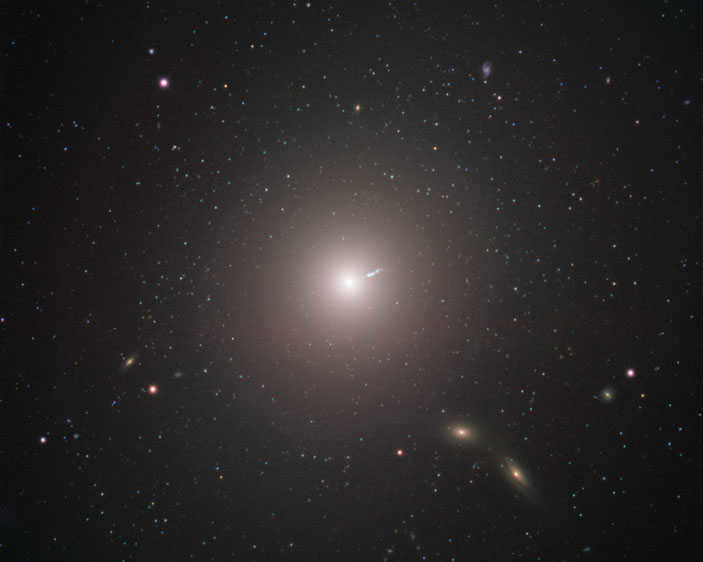

A captivating image showcasing the immense elliptical galaxy Messier 87, situated approximately 55 million light years away from our planet in the Virgo constellation. The remarkable jet emanating from the galaxy is prominently visible. This awe-inspiring photograph was captured at the prestigious Very Large Telescope (VLT) located in Chile. Photo: ESO
Previously, the detection of black holes was based on the detection of powerful radiation emanating from their vicinity. By virtue of their immense gravitational pull, they attract matter from the surrounding space. When matter falls onto a black hole, it accelerates to nearly the speed of light and becomes twisted around it, forming what is known as an accretion disk. Due to the friction within the disk, the plasma temperature reaches millions of degrees, resulting in the emission of thermal radiation. The motion of relativistic electrons in a curved magnetic field gives rise to synchrotron radiation. It is not uncommon for these black holes to exhibit jets of plasma that are ejected with tremendous speed. Both the accretion disk and the jets serve as powerful sources of radiation that span across the entire electromagnetic spectrum. In particular, accretion disks that form near supermassive black holes at the centers of certain galaxies are incredibly luminous and can outshine the combined light of billions of stars within the galaxy.
Confirmation of the presence of black holes also comes from the detection of gravitational waves resulting from their merger, which was discovered in 2015 (refer to the article “They exist! Gravitational waves have been registered” in “Science and Life” № 3, 2016).
What is the Event Horizon Telescope and how does it function?
Even the supermassive black holes located at the cores of many galaxies, including our own Milky Way, are relatively small entities, rendering direct observation impossible. No Earth-based telescope possesses the required resolution to observe regions of such scale. It is important to note that resolution is contingent upon the ratio of λ/D, where λ represents the wavelength of the received radiation and D represents the size of the telescope. A smaller wavelength and larger telescope size result in better angular resolution, allowing for the observation of finer details.
The creation of the EHT posed a significant technical challenge, involving the coordination and optimization of a global network of telescopes. While the telescopes were not physically linked, the data they collected had to be precisely synchronized using atomic clocks. The preparatory work for this endeavor spanned a decade and required an investment of 290 million dollars.
However, the EHT project is more than just an assemblage of telescopes; it is a collaborative effort involving over 200 astronomers from 60 research institutions across Europe, Asia, Africa, North America, and South America. To capture an image of the black hole through observation, extensive theoretical and simulation studies were conducted, alongside the development of advanced data processing algorithms.
From April 5 to April 11, 2017, the EHT conducted observations of M87 over a four-day period. A total of eight radio telescopes were involved in this project, including the ALMA, APEX (located in Chile), the IRAM 30-meter telescope (located in Spain), the James Clerk Maxwell JCMT and SMA Submillimeter Array (both located in Hawaii), the Alfonso Serrano Large Millimeter Telescope (LMT, located in Mexico), the Submillimeter Telescope (SMT, located in the USA), and the South Pole Telescope (SPT, located in Antarctica).
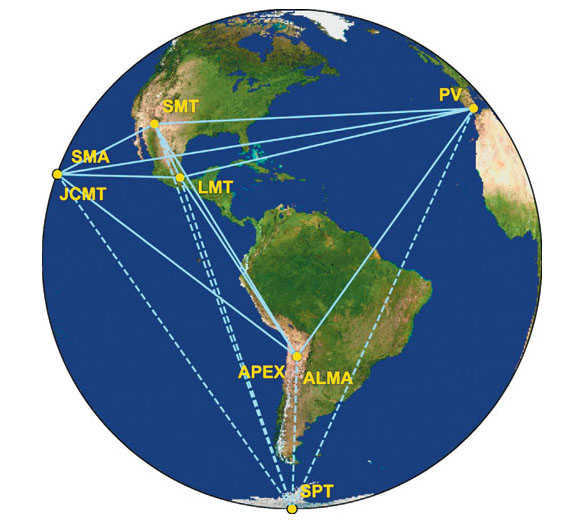
The April 2017 observations involved SST telescopes located in various parts of the world. The telescopes included SMA and JCMT in Hawaii, SMT in the United States, LMT in Mexico, ALMA and APEX in Chile, SPT in Antarctica, and PV (IRAM) in Spain. The pairs of telescopes that tracked M87 are represented by solid lines, while the dashed lines represent the pairs of telescopes used to calibrate the measurements for quasar 3C 279. This illustration is taken from a paper published in The Astrophysical Journal Letters, Volume 875, Number 1, under the CC BY 3.0 license.
The observations were conducted at a wavelength of 1.3 mm, which is close to the minimum wavelength that allows for the observation of space objects in the radio range on Earth. This is due to the fact that the Earth’s atmosphere is not transparent to all wavelengths of electromagnetic radiation. Radio astronomy operates within the window of atmospheric transparency, which spans from 1 mm to approximately 30 meters. Wavelengths smaller than this range are largely absorbed by atmospheric gas molecules, particularly water vapor, while longer wavelengths are reflected back into space by the ionosphere. It is important to note that small wavelengths are necessary in order to achieve high resolution.
Working at such short wavelengths presents numerous challenges, including increased noise in the electronics, absorption of radiation in the atmosphere, and heightened phase fluctuations caused by atmospheric turbulence.
During the course of the campaign, each EHT telescope collected a massive amount of data: 350 terabytes of information per day. This data was stored on high-performance hard drives and later sent to specialized supercomputers known as correlators, which are located at the Institute for Radio Astronomy of the Max Planck Society in Germany and the Haystack Observatory at MIT in the USA. Using state-of-the-art computational methods developed by the project’s participants, the data was processed and transformed into stunning images. The entire process of processing several petabytes of data from all the telescopes took two and a half years. To put this into perspective, if this amount of data were in the form of mp3 music files, it would take over a thousand years to listen to.
It should be noted that capturing a traditional photograph of an object is impossible in the radio band due to its long wavelength. Instead, the information regarding specific parts of the image is intricately encrypted within the interferometer data. Through complex calculations, this information is extracted and assembled into an image. However, it is incorrect to claim that these images are not genuine. It is important to consider that magnetic resonance imaging (MRI) also relies on computer data processing to generate images, yet these images accurately represent the physical state of the body and are effectively utilized in medical diagnostics.
Why M87?
The reason for choosing M87 as a subject of observation lies in the fact that it is located in the Virgo cluster of galaxies, which makes it an ideal candidate for studying supermassive black holes. In any galaxy, it is believed that there are numerous black holes with masses similar to that of stars, but their small sizes make them impossible to observe. On the other hand, supermassive black holes in the centers of galaxies are much larger, but they are also located much farther away. Currently, there are only two supermassive black holes that can be observed: one is Sgr A* in the center of our galaxy, and the other is the black hole in M87.
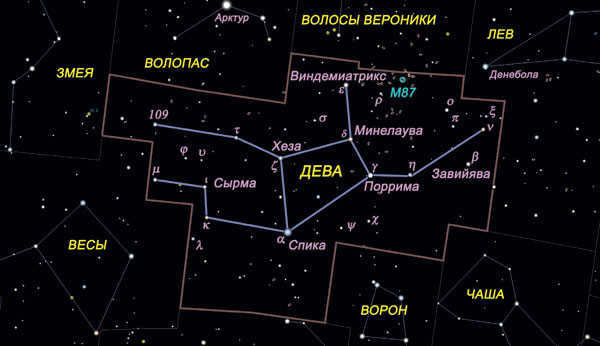
The constellation Virgo is where you can find the Galaxy M87, which was first discovered by Charles Messier in 1781. I used the program Stellarium to create a map of it.
M87’s black hole is located 55 million light-years away from Earth, making it two thousand times farther away than Sgr A*. However, in astronomical terms, it is considered to be very close. The size of a black hole’s event horizon is directly proportional to its mass. The black hole in M87 has a mass of 6.5 billion solar masses, which is 1500 times larger than Sgr A*. Because of its immense mass and its relatively close proximity to Earth, the black hole at the center of the M87 galaxy is one of the largest in terms of angular size for an observer on Earth, making it an ideal subject for study. Its event horizon measures 22 microseconds, only slightly smaller than Sgr A*’s 53 microseconds. To put it into perspective, it is comparable to the angular size of a matchbox placed on the Moon.
One more reason for selecting M87 is its visibility from both the North and South hemispheres of the Earth. This means that a wide range of ground-based telescopes can observe it, resulting in increased resolution of the captured images.
It is important to mention that due to its immense mass, the black hole in M87 exhibits less variability compared to Sgr A* (the time period for variability is in days rather than minutes). Variability poses a challenge for observations as it restricts the duration for receiving a stable signal. Additionally, Sgr A* is situated in the galactic plane and is obscured by gas and dust clouds, further complicating the efforts of researchers to obtain an image of it.
What can we observe within the picture of the black hole?
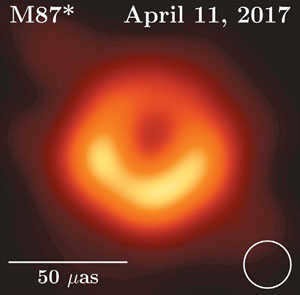
The Event Horizon Telescope (EHT) captured a remarkable image of a supermassive black hole located in the galaxy M87. The black hole’s “shadow” can be seen at the center of the bright ring, which has a radius approximately 2.6 times that of the event horizon. A line in the image represents an angular size of 50 microseconds, while a circle represents the resolving power of the EPT. This illustration is sourced from a paper published in The Astrophysical Journal Letters, Vol. 875, No. 1, under the CC BY 3.0 license.
The gravitational pull of a black hole is so strong that it prevents light from escaping. However, there are orbits around the black hole, located at a distance of 1.5 times the Schwarzschild radius (represented by RS), where light can actually move in a circular path. These orbits make up what is known as the photon sphere. It’s important to note that these orbits are unstable, meaning that photons approaching the black hole will be absorbed by it, while photons moving away from it will escape into space. This creates an interesting phenomenon for observers outside the black hole – they can see a narrow luminous ring in the shadow region, which corresponds to the photon sphere. However, due to the limited resolution of the image, it is impossible to clearly distinguish this ring.
The accretion disk emitting from the black hole in the center of the M87 galaxy is positioned at a slight inclination to the plane perpendicular to the Earth’s direction. As a result, the resulting image will display a brilliant ring with a distinct dark shadow at its center. However, the question remains: what will be the radius of this captivating phenomenon?
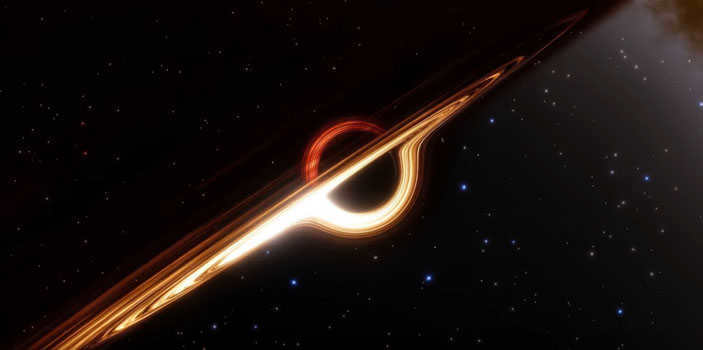
An artistic depiction of a black hole is shown in the image above, with an accretion disk facing towards the Earth. This illustration was created by ESO.
In order to gain a better understanding, let’s consider the opposite scenario: we will bombard the black hole with photons. The movement of a photon as it passes by the black hole can be measured using the aiming parameter b. This parameter represents the minimum distance at which the photon would come close to the center of the black hole, assuming it was moving in a straight line without being affected by gravity. Geometrically, this distance is equivalent to the length of the perpendicular line drawn from the center of the black hole to the straight line followed by the photon. A photon that is far away from the black hole will travel along this straight line. However, due to the gravitational pull, the trajectory of the photon becomes curved, resulting in a smaller value of b. As the aiming parameter decreases in value,
As the photon travels around the black hole, it will pass through the photon sphere and ultimately be absorbed by the event horizon. Reversing the motion of the photons reveals that radiation from the region around the black hole with a radius of 2.6RS cannot reach the observer, as the rays originate from the event horizon. This creates the phenomenon where the observer sees both the “face” and the “back of the head”. This is what we refer to as the “shadow” of the black hole with a radius of 2.6RS. The rotation of the black hole may slightly alter this value, but not by more than 4%.
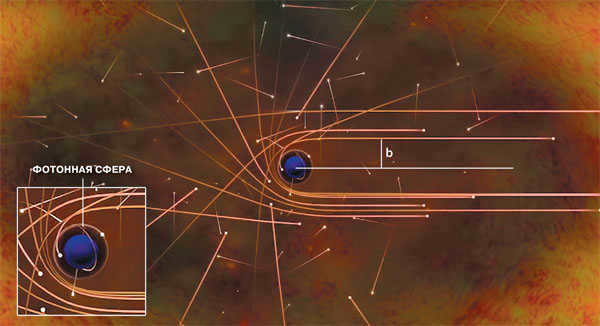

Photon trajectories in the vicinity of the black hole. The gravitational curvature and capture of light rays with the aiming parameter b less than 2.6RS, as they cross the photon sphere are responsible for the formation of the “shadow”. The image of this shadow was captured by the Event Horizon Telescope. Below is a perspective of the photons as seen from the observer’s point of view. Illustration: ESO
When the accretion disk is tilted towards the observer at an angle, it is fascinating to observe the resulting phenomenon. Would our perception be limited to just a narrow strip of the disk, similar to what one would see if a coin was turned on its edge? At first glance, it may seem that this would be the case, but this assumption is incorrect. Once again, the curvature of light rays in a powerful gravitational field comes into play. Radiation emitted from the unseen half of the accretion disk behind the black hole will be bent around it due to gravity, resulting in the appearance of a luminous ring surrounding the dark silhouette with the same radius as the “shadow”. A similar depiction of a black hole can be seen in the movie “Interstellar”.
It is evident that the image acquired through EPT displays asymmetry – the lower portion appears significantly brighter. This phenomenon is attributed to the Doppler amplification, which causes the radiation emitted by matter approaching us to appear brighter than that receding from us.
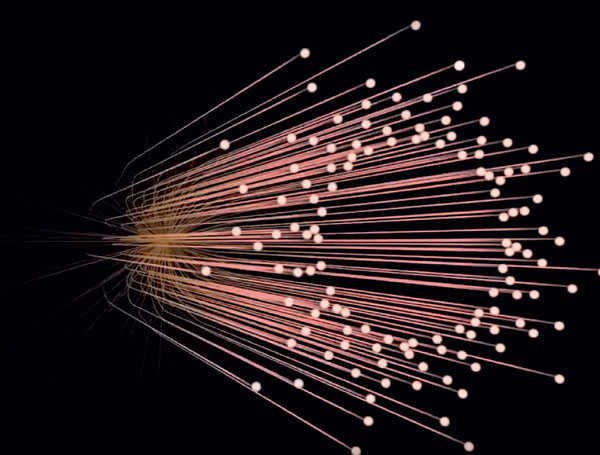
What causes the blurriness of the image?
The blurriness of the image is primarily caused by the insufficient resolution, which is similar to the size of the black hole. It can be likened to a small painting made with a thick brush. However, it’s important to note that a higher resolution doesn’t necessarily guarantee better image quality.
The main idea is that the EHT gathered data from the black hole using a limited number of telescopes for a short period of time. These telescopes are also engaged in various other research projects. Each measurement only captured a small portion of the targeted region. Additionally, interferometry only provides a high-resolution image along the line connecting the two telescopes in use. Due to the incomplete measurements, there were numerous unexplored areas between the obtained fragments. Consequently, the researchers had to reconstruct the complete image by filling in these gaps. This process is akin to restoring a partially damaged mosaic painting on a wall, where only a few individual fragments remain, and restorers must piece them together to recreate the original image. Advanced visualization algorithms are employed to fill these gaps and generate an image of the black hole. However, it is important to note that the filled areas cannot provide accurate details of the original image and are essentially filled in a certain manner. As a result, the resulting image is blurry and lacks fine details.
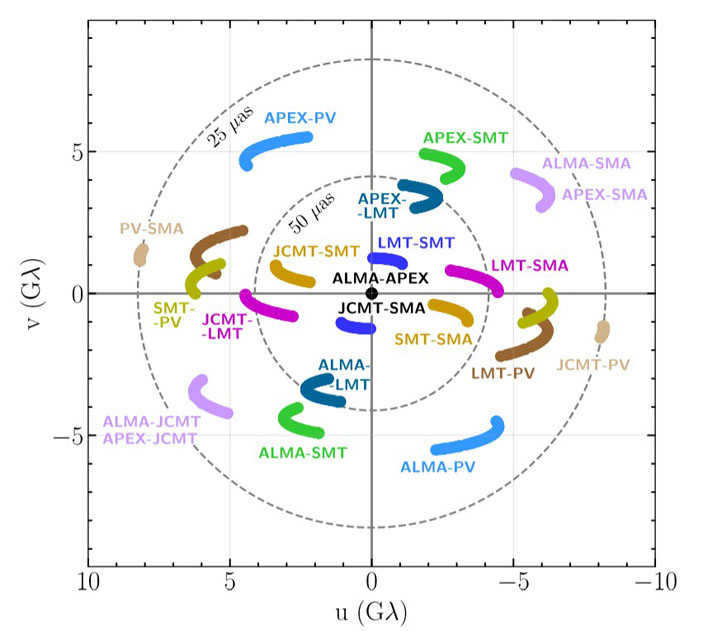

The worm-like structures exhibit sections of the investigated area on the (u,v)-plane utilized in interferometry, observed by the Event Horizon Telescope. Each one is labeled with the telescope pair that conducted the measurements. The remaining blank area is then filled in using a visualization algorithm to generate the image. Illustration derived from a paper in The Astrophysical Journal Letters, V. 875, N. 1, CC BY 3.0. Illustration: ESO
By the way, computer programs that work with photos often employ similar algorithms. When a photo is enlarged, the program spreads out its pixels and fills in the gaps between them using a specific algorithm. It is evident that this process causes the photo to lose its sharpness and appear blurry.
However, this raises the question of how closely the restored image aligns with reality, as the mosaic fragments can potentially create numerous different pictures. This is where modeling comes in to assist scientists in selecting the most plausible images from all the possibilities.
Additionally, another challenge arises from the suboptimal positioning of existing telescopes, which hinders their utilization for studying this object through interferometry.
What is the significance of this event?
Astrophysicists have long been certain of the existence of black holes, although until recently, they only had a theoretical model that accurately described various astrophysical phenomena such as galaxy nucleus radiation and double X-ray systems. While this model was essential for explaining these observed phenomena, it remained just a model. However, with the recent observation of a black hole, its existence has become an observable fact. Additionally, this is the first time there has been experimental confirmation of black hole rotation.
The new findings from the Event Horizon Telescope (EHT) did not significantly alter our understanding of black holes. In fact, the properties of the observed image surprisingly align well with existing theoretical ideas. Nevertheless, these results provide confidence in the accuracy of the measurement methods and the interpretation of the findings, including estimates of black hole mass.
However, in the coming years, the refined technique and extensive observations, potentially with the involvement of a space telescope, will enable detailed examination of the phenomena occurring in the vicinity of a black hole, which have thus far only been conceptualized. This breakthrough will empower astrophysicists to better comprehend the profound gravitational effects anticipated near a black hole, as well as gain insights into the behavior of matter in its proximity, such as the mechanisms governing the formation of jets.
The results of the observations can be utilized to examine the general theory of relativity and various alternative theories of gravity, which predict, for instance, a distinct form of “shadow”. Therefore, according to the general theory of relativity, a black hole’s “shadow” will be circular, while other theories propose that it is compressed along different axes and possesses a intricate shape. However, in order to discern the discrepancies, a clearer image of it is required.
One of the future objectives of the EHT is to comprehend why the supermassive black hole at the core of the Milky Way, unlike other galaxies, is a somewhat faint object – its luminosity is only a few hundred times that of the Sun.
Is Russia going to participate in the project?
Russia’s absence from the project was mainly due to the lack of modern radio telescopes operating in the millimeter wavelength range. The country’s largest space radio telescope, “Radioastron,” which was launched in 2011, has an antenna diameter of 10 meters and operates in the centimeter range, achieving impressive resolution values.
However, there is a possibility of change in the situation. In 2018, Russia and Uzbekistan made the decision to resume the construction of the unique Suffa radio telescope on the plateau of the same name in southern Uzbekistan. This telescope is designed to operate in the millimeter range and has a planned operational date of 2024. The construction of this 70-meter radio telescope originally began in 1985 but was put on hold in 1991. The estimated cost of completing the project is around 4 billion rubles.
Additionally, Russian astronomers are planning to send a space observatory called “Millimetron” (Spektr-M) into orbit. This observatory features a 10-meter mirror and is specifically designed for research in the millimeter and infrared ranges. Due to its location in space, the Millimetron telescope greatly enhances the resolution power of the interferometer. However, it is unlikely that Millimetron will be launched before 2030.
If these telescopes become operational, Russia could potentially join the EHT project.
Black holes are incredibly fascinating and simultaneously terrifying entities within our Universe. They form when massive stars exhaust their nuclear fuel, causing nuclear reactions to cease and the stars to cool down. Under the influence of gravity, the star’s body begins to collapse and gradually attracts smaller objects, ultimately transforming into a black hole.
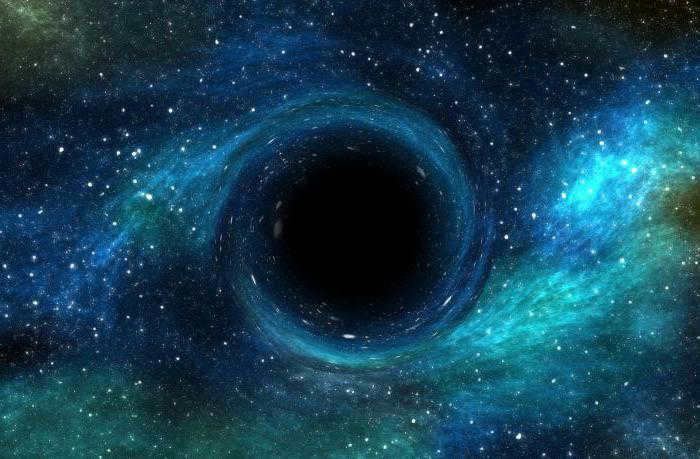
The initial research
The exploration of black holes by scientists started relatively recently, despite the fact that the fundamental principles of their existence were formulated in the previous century. The term “black hole” was first introduced by J. Wheeler in 1967, but the understanding that these entities are formed when massive stars collapse dates back to the 1930s. Anything that ventures too close to the boundaries of a black hole, including asteroids, light, and comets, becomes trapped inside and cannot escape.
The Limits of Black Holes
The first boundary of black holes is known as the static limit. This marks the point at which an external object can no longer remain at rest and begins to rotate in relation to the black hole, preventing it from being pulled into its gravitational pull. The second boundary is called the event horizon. Once matter crosses this boundary, it is irreversibly drawn towards the singularity, a point of infinite density. The laws of physics within this dense region are currently unknown to humans, making it impossible to describe its characteristics. This area remains a “black hole” in our understanding of the universe.
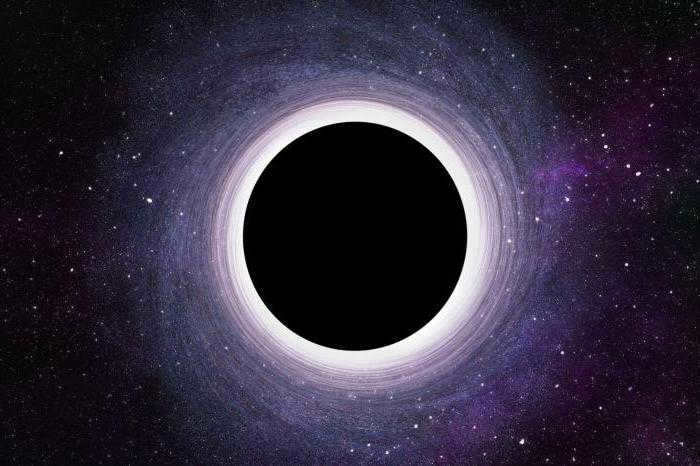
The Composition of Black Holes
The event horizon is known as the impenetrable boundary of a black hole. Within this boundary lies a region from which even objects traveling at the speed of light cannot escape. Even particles of light themselves, known as photons, are unable to leave the event horizon. Once an object crosses this threshold, it can never escape the black hole and become visible to outside observers. The exact nature of what lies inside a black hole is unknown, as it is believed to contain a singularity, a point of infinite density formed by the extreme compression of matter. Conversely, those within black holes are unable to observe any events occurring outside.
The event horizon encompassing this enigmatic celestial entity always expands in direct correlation with the mass of the abyss. Should its mass be amplified, the external perimeter will correspondingly increase twofold. Were scientists to discover a means to metamorphose the Earth into a black hole, the event horizon would be a mere 2 centimeters in diameter.
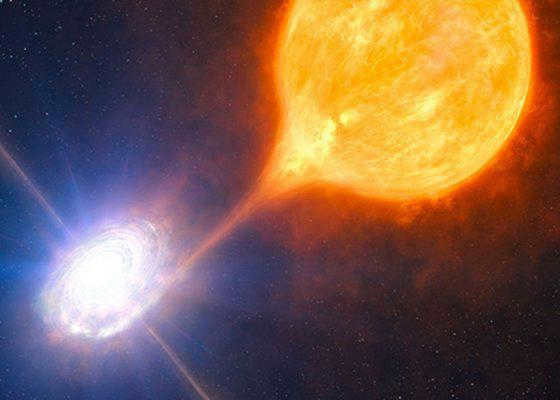

Main classifications
Typically, the mass of average black holes is around three solar masses or higher. There are two primary classifications of black holes: stellar black holes and supermassive black holes. The mass of supermassive black holes exceeds that of the Sun by several hundred thousand times. Stellar black holes are formed after the demise of large celestial bodies. Ordinary mass black holes emerge after the life cycle of massive stars concludes. Despite their different origins, both types of black holes possess similar characteristics. Supermassive black holes are typically found at the centers of galaxies. It is speculated by scientists that they were formed during the birth of galaxies through the amalgamation of closely neighboring stars. However, these assumptions are not substantiated by factual evidence.
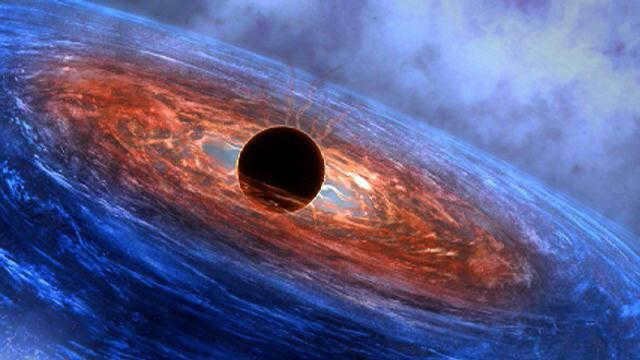
Speculation on the Contents of a Black Hole
Speculation among mathematicians suggests that black holes may contain wormholes, which would serve as gateways to other universes. Essentially, there would be a space-time tunnel at the singularity point. This concept has captured the imaginations of many writers and filmmakers. However, the majority of astronomers dismiss the idea of inter-universe tunnels. Moreover, even if such tunnels did exist, humans would have no means of exploring the contents of a black hole.
Another concept proposes the existence of white holes at the opposite end of these tunnels. These white holes would emit vast amounts of energy from our universe into another world through the black holes. However, given the current state of scientific knowledge and technological development, traveling through these tunnels remains purely speculative.
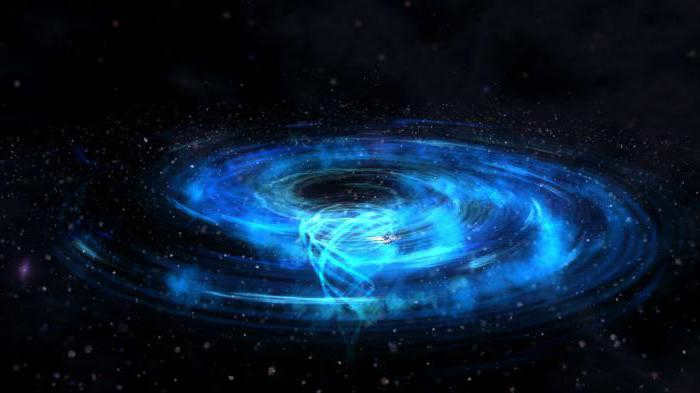
The Theory of Relativity and Black Holes
Black holes are an astonishing phenomenon predicted by Albert Einstein’s theory of relativity. According to this theory, the gravitational force on the surface of any planet is inversely proportional to the square of its radius and directly proportional to its mass. This means that as the mass of a celestial body increases and its diameter decreases, the second cosmic velocity required to overcome its gravitational force can eventually exceed the speed of light. However, according to the theory of relativity, no object can travel faster than the speed of light. As a result, a black hole is formed, trapping everything within its boundaries and preventing anything from escaping.
In 1963, the discovery of quasars revolutionized our understanding of the cosmos. These cosmic objects emit massive amounts of radio waves and are located billions of light years away from Earth, far beyond our galaxy. Scientists have proposed that the incredible energy output of quasars can be explained by the presence of black holes within them. This hypothesis has gained widespread acceptance within the scientific community and has been supported by numerous studies conducted over the past half-century. In fact, it has been concluded that black holes exist at the center of every galaxy, including our own. Our galaxy, the Milky Way, is no exception, with a massive black hole known as Sagittarius A residing at its core. With a mass equivalent to 4 million suns, Sagittarius A is of particular interest to astronomers due to its proximity to Earth.
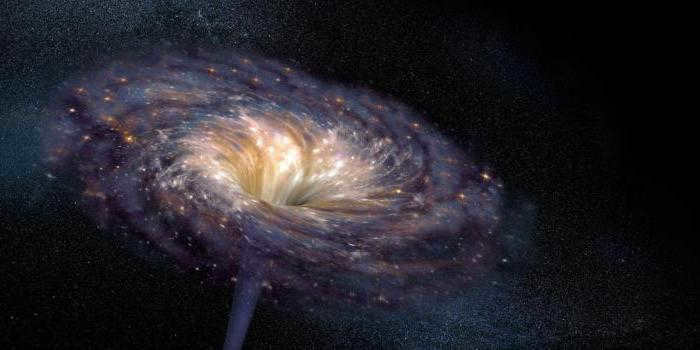
The Phenomenon of Hawking Radiation
Modern scientists face a great challenge due to the discovery of a particular type of radiation by the renowned physicist Stephen Hawking. This discovery has significantly complicated the understanding of black holes in the field of physics. In classical physics, the concept of vacuum refers to a state of complete emptiness and absence of matter. However, the advancement of quantum physics has led to a modification of this concept. Scientists have discovered that the vacuum is filled with virtual particles that can transform into real particles under the influence of a strong field. In 1974, Hawking made the groundbreaking observation that such transformations can occur in the strong gravitational field near the event horizon of a black hole. This process involves the simultaneous creation of a particle and its antiparticle. Typically, the antiparticle is destined to be pulled into the black hole, while the particle escapes. As a result, a radiation phenomenon known as Hawking radiation is observed around these cosmic objects.
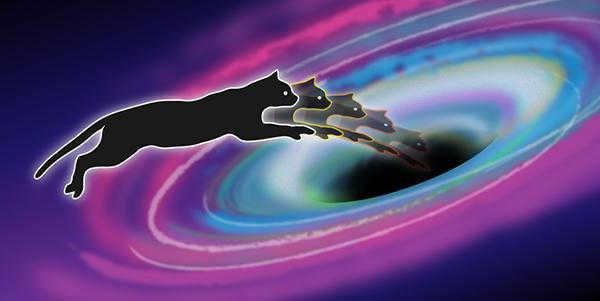
The dilemma of preserving information
Following the revelation of Hawking radiation, a pressing issue that emerged is the conundrum of information loss. This quandary is rooted in a seemingly straightforward question: what occurs when a black hole completely evaporates? Both classical and quantum physics theories grapple with elucidating the state of a system. By possessing knowledge of the initial state of the system, the theory can be employed to expound on its transformation.
While the process of evolution occurs, it is important to note that information regarding the original state remains intact – a law of information conservation is in effect. However, when a black hole completely evaporates, observers lose information regarding the portion of the physical world that was once absorbed by the black hole. Stephen Hawking proposed that information regarding the initial state of the system somehow reemerges after the complete evaporation of the black hole. Nevertheless, the challenge lies in the fact that, by definition, it is impossible for information to be transmitted from within a black hole, as nothing can escape its event horizon.

